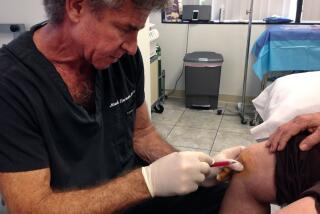Critiquing the stem cell board

- Share via
After years of resisting all criticisms of its operations, the California Institute for Regenerative Medicine is finally listening — a little. It spent $700,000 for an outside, high-level review that complimented the stem cell agency for funding an excellent portfolio of research projects, but also raised serious objections to the agency’s structure, which the review said was likely to lead to financial conflicts of interest.
The criticisms were nothing new — many of the same points have been made since the agency was created by Proposition 71 in 2004 — but the positive response by the chairman of the agency’s board was. The governing board is now making changes to address some of the long-standing issues.
Yet the agency isn’t exactly embracing an ethical overhaul. It’s doing just enough to address the criticisms without triggering any oversight from the Legislature. The modifications are more a bandage than a cure. Like a bandage, they will probably do, but only for a limited time.
The single biggest problem identified in the report by the Institute of Medicine, an arm of the National Academy of Sciences, was that the large governing board, which approves all of the grants made from the
$3-billion bond that funds the stem cell agency, includes 13 representatives from institutions that apply for the grants, such as the state’s large research universities. And even though they can’t vote on applications from their own organizations, the concern has been that some mutual hand-washing might be taking place, especially considering that during the first several years, 90% of the grants went to those organizations. The report advised the stem cell agency to have grant decisions made by outside experts who had no stake in the outcome.
The agency isn’t going that far. Instead, it adopted a voluntary policy under which the grant-eligible board members are supposed to abstain from voting on all funding applications.
Why not just change the board’s makeup? The current structure was built into Proposition 71, so any change would require a bill passed by 70% of the Legislature. It seems clear that the agency, which has enjoyed extraordinary freedom from government oversight, wants to keep things that way. Any reform bill has little chance of gaining a 70% vote without the agency’s support.
If the stem cell institute is just a temporary agency that will last until its public funding runs out — it plans to give its last grants with existing funds in 2017 — its planned reforms will probably be enough. But if the institute wants to be a permanent part of the research landscape — and possibly ask for more public funding — voluntary recusals are an inadequate patch. The agency’s leaders should admit that the original setup was flawed and seek a true fix.
More to Read
A cure for the common opinion
Get thought-provoking perspectives with our weekly newsletter.
You may occasionally receive promotional content from the Los Angeles Times.






